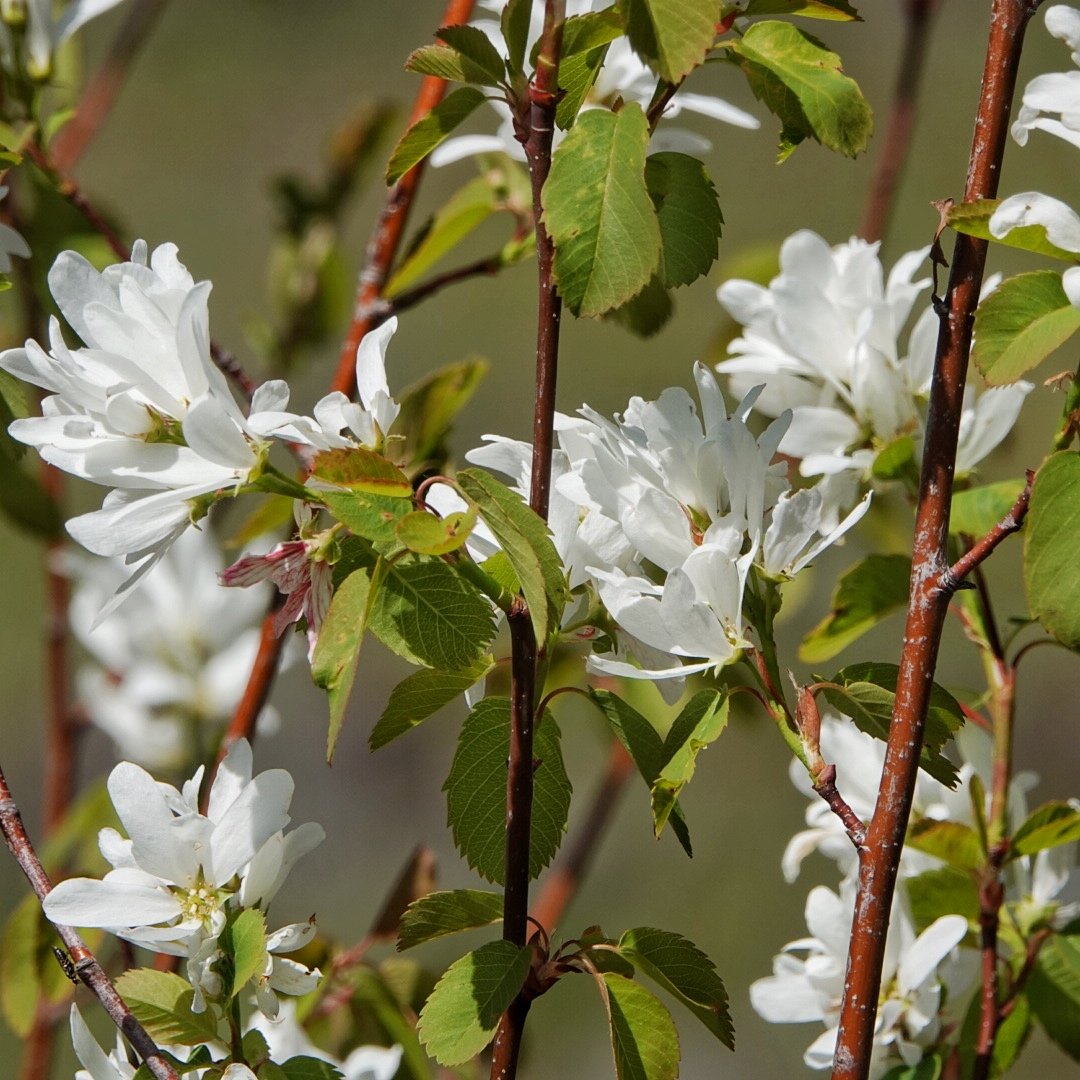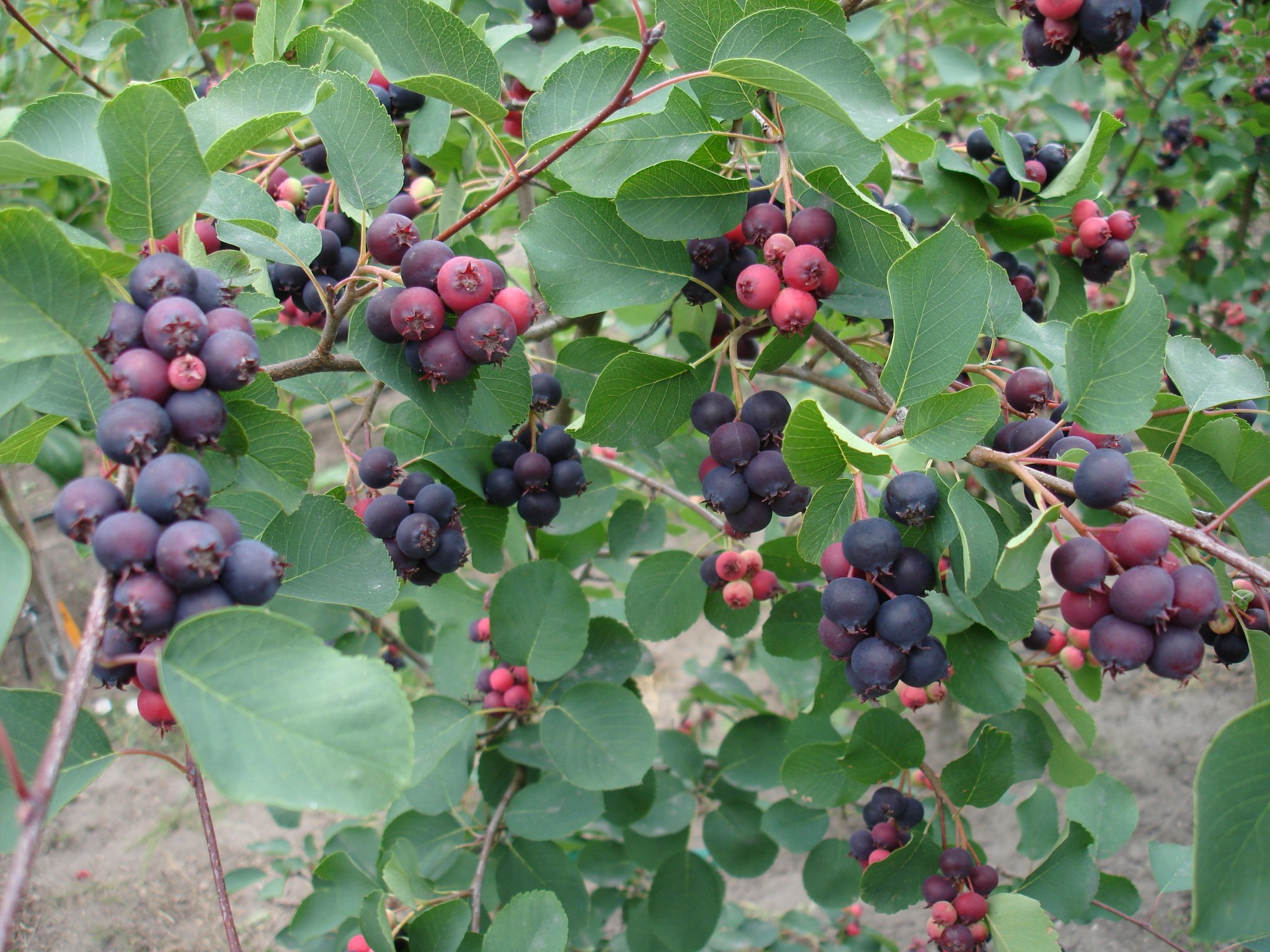Serviceberry
Amelanchier spp. Also known as shadbush, shadblow, juneberry, or saskatoon.
Serviceberry is native to temperate regions of the Northern Hemisphere, growing primarily in early successional habitats. It is most diverse in North America, especially in the northeast, and at least one species is native to every U.S. state except Hawaii. Beautiful fragrant 5-petaled white flowers are early harbingers of spring in Maine but this is also a very valuable wild edible. All species are low-maintenance, generally disease and pest free (susceptible to leaf spot and rust but does not affect fruit), and tolerate a wide range of cultural conditions. Plant in full sun and well drained soils for best berry production.
alnifolia: native to western Canada and mountainous parts of the western United States; domesticated for commercial fruit production. Upright suckering large shrub that grows slowly up to 15 feet tall and wide.
arborea:native to eastern North America; typically grows on wooded slopes and cliffs, open woods, wooded bluffs, rocky woodlands, limestone glades, riverbanks, and edges of swamps. It has a multistemmed habit as a small tree or, if the root suckers are not removed, it will attain a more shrubby like form. Typically growing 15 to 25 feet tall with a narrow, rounded form, it can reach heights of 40 feet in the wild.
laevis: native to eastern North America; often found in and along the edges of open woods. Some say this species of serviceberry has the sweetest, juiciest berries. Similar growth habit to arborea in growth habit but is sometimes trained into single trunk form.
Regent: compact prolific cultivar of alnifolia growing to 4-6 feet tall and wide; purplish-black sweet berries about the size of a lowbush blueberry, or a bit larger, and seedier. Nice red-orange fall foliage. An open-pollinated seedling originating near Regent, ND; fruit ripens in mid-July in central Maine.
These are a great tasting berries, most similar to blueberry but generally smaller, and great for pies, cobblers, jellies, jams, smoothies and cakes. Favorite of birds and many small animals.
Sold as bare-root seedlings 12-24” tall.
Amelanchier spp. Also known as shadbush, shadblow, juneberry, or saskatoon.
Serviceberry is native to temperate regions of the Northern Hemisphere, growing primarily in early successional habitats. It is most diverse in North America, especially in the northeast, and at least one species is native to every U.S. state except Hawaii. Beautiful fragrant 5-petaled white flowers are early harbingers of spring in Maine but this is also a very valuable wild edible. All species are low-maintenance, generally disease and pest free (susceptible to leaf spot and rust but does not affect fruit), and tolerate a wide range of cultural conditions. Plant in full sun and well drained soils for best berry production.
alnifolia: native to western Canada and mountainous parts of the western United States; domesticated for commercial fruit production. Upright suckering large shrub that grows slowly up to 15 feet tall and wide.
arborea:native to eastern North America; typically grows on wooded slopes and cliffs, open woods, wooded bluffs, rocky woodlands, limestone glades, riverbanks, and edges of swamps. It has a multistemmed habit as a small tree or, if the root suckers are not removed, it will attain a more shrubby like form. Typically growing 15 to 25 feet tall with a narrow, rounded form, it can reach heights of 40 feet in the wild.
laevis: native to eastern North America; often found in and along the edges of open woods. Some say this species of serviceberry has the sweetest, juiciest berries. Similar growth habit to arborea in growth habit but is sometimes trained into single trunk form.
Regent: compact prolific cultivar of alnifolia growing to 4-6 feet tall and wide; purplish-black sweet berries about the size of a lowbush blueberry, or a bit larger, and seedier. Nice red-orange fall foliage. An open-pollinated seedling originating near Regent, ND; fruit ripens in mid-July in central Maine.
These are a great tasting berries, most similar to blueberry but generally smaller, and great for pies, cobblers, jellies, jams, smoothies and cakes. Favorite of birds and many small animals.
Sold as bare-root seedlings 12-24” tall.
Amelanchier spp. Also known as shadbush, shadblow, juneberry, or saskatoon.
Serviceberry is native to temperate regions of the Northern Hemisphere, growing primarily in early successional habitats. It is most diverse in North America, especially in the northeast, and at least one species is native to every U.S. state except Hawaii. Beautiful fragrant 5-petaled white flowers are early harbingers of spring in Maine but this is also a very valuable wild edible. All species are low-maintenance, generally disease and pest free (susceptible to leaf spot and rust but does not affect fruit), and tolerate a wide range of cultural conditions. Plant in full sun and well drained soils for best berry production.
alnifolia: native to western Canada and mountainous parts of the western United States; domesticated for commercial fruit production. Upright suckering large shrub that grows slowly up to 15 feet tall and wide.
arborea:native to eastern North America; typically grows on wooded slopes and cliffs, open woods, wooded bluffs, rocky woodlands, limestone glades, riverbanks, and edges of swamps. It has a multistemmed habit as a small tree or, if the root suckers are not removed, it will attain a more shrubby like form. Typically growing 15 to 25 feet tall with a narrow, rounded form, it can reach heights of 40 feet in the wild.
laevis: native to eastern North America; often found in and along the edges of open woods. Some say this species of serviceberry has the sweetest, juiciest berries. Similar growth habit to arborea in growth habit but is sometimes trained into single trunk form.
Regent: compact prolific cultivar of alnifolia growing to 4-6 feet tall and wide; purplish-black sweet berries about the size of a lowbush blueberry, or a bit larger, and seedier. Nice red-orange fall foliage. An open-pollinated seedling originating near Regent, ND; fruit ripens in mid-July in central Maine.
These are a great tasting berries, most similar to blueberry but generally smaller, and great for pies, cobblers, jellies, jams, smoothies and cakes. Favorite of birds and many small animals.
Sold as bare-root seedlings 12-24” tall.



